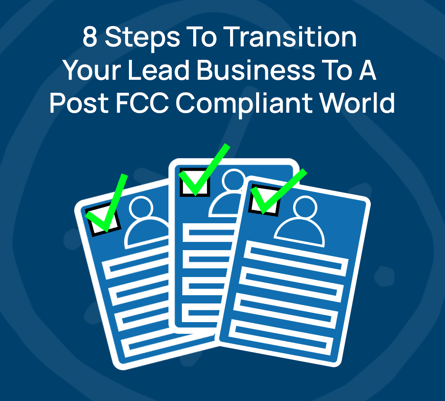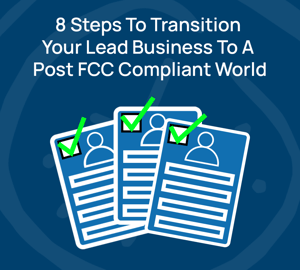Disclaimer: On January 24th, 2025, the FCC’s one-to-one consent rule, which required lead generators to obtain direct consent for each seller before contacting consumers, was struck down by the U.S. Court of Appeals for the Fifth Circuit. This means that, as of now, the rule is no longer in effect. However, businesses should continue to follow existing TCPA regulations and stay informed about any further legal developments or enforcement actions. This is not legal advice—please consult with a qualified attorney for compliance guidance. Please see this blog for more information.
Complying with the FCC regulations for lead generation is a massive undertaking in a short time. The question "How do I comply with the FCC lead generation regulations" is on everyone's minds in the industry. Using these eight steps, you can adapt your current lead generation business to fit the upcoming regulations. These will include using dynamic consent, correct documentation, and training.

1. Understand the New FCC Rulings
The first step to comply with the new regulations is to understand what you need to do. There are some resources out there that describe the ruling and what it means. Seeking legal counsel may be a good idea if you need a second opinion after you plan your strategy.
2. Audit Current Practices & Develop Strategy
The biggest thing for the FCC ruling is one-to-one consent for those contacting them. Go through your current flow with your leads; who is the end buyer? Where will you need to get consent? How can you display that in your current flow? Do your buyers have a specific text they use for consent to contact? Once you have these questions, start filling in the answers to bridge the gaps with compliance.
3. Implement Technology Solutions
These changes affect the entire industry, so some software providers may already have some answers for your consent gaps.
Dynamic consent - ping post in a post-FCC world
Dynamic consent is the ability to return potential service providers to the consumer, allowing them to select who gets their information. This is a solution boberdoo has in their Dynamic Consent flow. To summarize, a lead fills out partial information, such as zip code and project type, and then matches with buyers. The lead can consent to all buyers they would like to have to contact them on the next page in the same form and input their information. Dynamic consent is how you can use ping post within the FCC's guidelines.
Proof of Consent
The new rules make it even more important that you include certificates for authentication. You can add certifications such as Trusted Form and Jornaya to your leads in boberdoo's Outside Services where you can integrate your account credentials from third-party providers you choose. Tracking and verifying your leads protects you. The ruling makes it clear that you must know the origin of your leads and you must keep track of them.
Vetting Data Vendors
Now, it is more important than ever before to vet your vendors. You will need to know if they have followed the FCC's guidelines and are only having who the lead consented to contacting them. Using Assumed, you can submit a lead to one of your partner's forms. From there, you can see all the emails, texts and calls the lead has received. If that contact receives any calls or texts they did not consent to, that breaches the FCC's guidelines. Know who you're working with and vet your vendors.
4. Train Your Staff
It only takes one slipup to be under TCPA scrutiny. Be sure that your employees understand the FCC's guidelines, so they avoid accidentally reaching out to someone who does not have the proper consent.
5. Monitor and Adjust
Monitor how these new practices work out for your business. It is good to start these changes before the ruling goes into effect so you have some wiggle room if something will not be compliant. You can test different software options and flows to get everything in order before it becomes a real problem.
6. Document Compliance Efforts
Keep detailed records of compliance efforts, including changes made to processes, training provided to staff, and any consumer consent obtained. This documentation can be crucial in demonstrating that you received the proper consent. Documenting consent and organizing where your consent records will stay will be crucial. You will need to show proof that you are, in fact, following the guidelines, and it will be on you to prove it, not the consumer. See the software above that streamlines this process for documenting consent.
7. Communicate with Stakeholders
Inform stakeholders, including customers, partners, and vendors, about the changes and how they might impact interactions with the business. Being transparent is the best way to go about these upcoming changes and to work together to collaborate on solutions. Having the previously mentioned plan will help this move along smoothly and with more answers than questions.
8. Stay Informed and Adapt
Regulatory environments can evolve. Stay informed about any further changes in FCC regulations or related legal requirements, and be prepared to adapt as necessary. Subscribe to newsletters and public figures in the industry to stay ahead of all these changes. Be proactive instead of reactive.
Bonus Tip. boberdoo has been aware that this would happen from the start and has always strived to keep consumer consent at the forefront. With over 22 years in the industry, we have seen all different types of companies and developed distribution strategies for many of them. We already have dynamic consent in our arsenal, and if you are looking for some assistance, feel free to reach out about your business and what you can do before the FCC ruling comes into effect.
Adapting to the FCC's regulations for lead generation will be a challenge for most, but it can be a seamless transition with a strategic approach and having the right pieces in order. Remember, the essence of these changes is not just about meeting legal requirements; it's about fostering a more transparent and respectful relationship with your consumers. They are the true backbone of this industry and were able to be abused for decades by bad actors in this industry. As you move forward, remember that this is an ongoing journey. Embrace these changes as an opportunity to enhance your business practices, strengthen trust with your clients, and lead the way in ethical lead generation. With diligence, collaboration, and a commitment to compliance, you can navigate this industry in a post-FCC world confidently and successfully.


